Credits:Biovision-Infonet
A breed is a group of domestic animals with a uniform appearance, behavior, and other characteristics that distinguish it from other animals of the same species. It is developed as a result of intensive selection of desirable traits within a large population until the selection goal has been achieved, usually after the fourth generation. Then the breed is considered to be a pure breed.
A cross bred animal results from the mating of two pure breeds of the same species. Very often this cross has qualities which are better than either of the parents. This phenomenon is called heterosis or hybrid vigour and is widely used in livestock improvement. If more improvement is desired, then “grading-up” should be done. This is a process whereby the cross bred female offspring is continually crossed with the desired male until a synthetic breed is realized.
Sheep fall into four categories: mutton, wool, dairy and dual (multi) purpose: e.g. mutton and wool, or mutton and milk. However, a majority of the current commercial breeds have been developed with specialization to one primary product in mind e.g. milk or mutton.
When selecting animals, it is important to think about the environment that they are to live in. Many pure bred animals come from Europe, where the climate is cool and good quality fodder plenty. These sheep are not usually suited for hot dry areas with little available fodder.
Hair Sheep breeds: The major hair sheep breeds include: Dorper; Nyanza Fat-tail; Persian Black Head; Red Masai and crosses of these four with local stock. The hair sheep are mainly reared in the arid and semi arid areas.
Wool and Dual purpose breeds: The major wool and dual purpose sheep breeds include: Merino; Corriedale; Hampshire Down; Romney Marsh and crosses of these breeds with local stock. The wool sheep are reared mainly in the cool high rainfall areas.
Common breeds suitable for different regions in Kenya:
| Region | Sheep |
| High altitude | Corriedale, Merino, Hampshire Down, East African fat rumped type |
| Medium altitude | Dorper, East African fat rumped type, East African fat tailed type |
| Low altitude | Red Masai, Dorper, Persian black head |
Hair sheep
a) Dorper Sheep
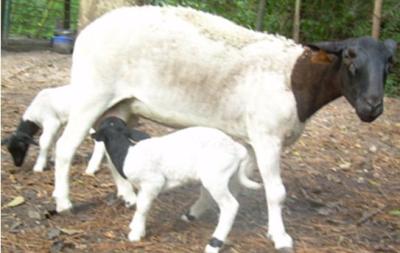
(c) www.fergusfarm.org
Origin and distribution: The Dorper, is a composite breed of South Africa developed at The name ‘Dorper’ is a coupling of the first syllables of the parent breeds Dorset and Persian Grootfontein in 1940-50 by the Department of Agriculture and some farmers to produce maximum number of lambs with good mutton qualities, which could be marketed off arid and extensive grazing conditions. It was developed through the crossing of the Blackhead Persian ewes with the Dorset Horn rams. The name ‘Dorper’ is a coupling of the first syllables of the parent breeds Dorset and Persian. A fixed type was developed through inter-se mating. A breed society was established in 1950 in the Republic of South Africa. The Dorsian (White variety) was affiliated to Dorper in 1964. The Dorper sheep thrive in arid to semi-tropical climate and are suitable for areas with rainfall of only 100 to 760 mm. Although this breed was developed originally for the more arid areas, today they are widely spread throughout the continent.
Physical characteristics: The typical breed standard involves a short loose light covering of hair and wool (wool predominating on the forequarter) with a natural clean kemp underline. The breed is barrel-shaped, hornless (polled) with short, dull black or white hair on the head, often with black feet; they have short hair and coarse wool; the black headed ones are called “Dorper” and the white headed ones “White Dorper”.
Peculiarity: The peculiar features for the Dorper is that they were developed for arid to semi-arid environments, but are well adapted to, and perform favorably under a variety of climatic and grazing conditions, including intensive feeding systems. They are non-selective grazers and fit well in cool climates where they can be used to convert feed resources, which are not utilized or underutilized by other livestock. They have a high lambing percentage reaching up to 180% and can produce 2.25 lambs on an annual basis. Rams reach sexual maturity at an early age, rams have been observed to start working by five months.Their inherent growth potential is such that they can attain live weight of 36 kg at 3-4 months of age. They have also a very even temperament.
Utility: The breed is not only ideally suited to the purpose for which it was bred, but is adaptable to a variety of conditions throughout the world and makes a huge contribution to mutton production worldwide. It has a long breeding season which is not seasonally limited so that lambs can be dropped at any time of the year. Lambing intervals is about eight months, so under good conditions they can drop lambs three times in two years. The average litter size is 1.19 to 1.5. A lambing percentage of 150% can be reached under good conditions while, in exceptional cases, 180% can be attained. Thus on average a Doper ewe can produce 2.25 lambs on an annual basis.
Table 1 Reproduction per 100 Doper ewes mated
| Variable | Number of ewes | Lambs born | Lambs weaned |
| Ewes mated | 100 | ||
| Ewes lambed | 95 | ||
| Ewes with single lambs | 61 | 61 | 60 |
| Ewes with twin lambs | 30 | 60 | 58 |
| Ewes with triplet lambs | 4 | 12 | 10 |
| Total number of lambs | 133 | 128 |
Source: Campbell (2000)
- Average birth weight was 3.48 kg for males and 3.37 kg for females.
- Adult live-weight was 74 kg for males and 44 for females (DAD-IS 2005).
- The Dorper lamb can reach a live-weight of about 36 kg at the age of 3-4 months.
- The daily gain averages at 243 g. This ensures a high quality carcass of approximately 16 kg and is associated with the inherent growth potential of the Dorper lamb and its ability to graze at an early age.
- In more marginal areas of Kenya’s Machakos District, Dorper ewes registered 10% twining rate, 78% lambing (fertility) rate, average birth weight of 3.6kg, pre-weaning lamb growth and mortality rates of 178 g/day and 14%, respectively. Average pre-weaning daily gains is 183 g/day and lamb mortality rate is 3.5% and with average weaning weights of 23.8 kg at 109 days.
Dorper ewes produce a large quantity of milk, are instinctively fond of their lambs and therefore care for, and rear, their offspring well. The Dorper ewe will nourish her lambs under difficult conditions. When the ewes are left alone they will lamb easily, and will retain and look after their lambs.A well-grown Dorper lamb has carcass qualities with respect to conformation and fat distribution, which generally qualifies for a super grading. Dressing percentages can reach 54%. In South Africa, Dorper hides are sold as top quality leather under the name “Cape glovers” and represents 20% of the total carcass value. The Dorper are not susceptible to fly strike and fleece rot. They have a high degree of disease resistance.
Dorper sheep are susceptible to gastro-intestinal nematodes (Haemonchus contortus) and have higher mortality from birth to yearling compared to Red Maasai and their crosses.
b) Red Maasai
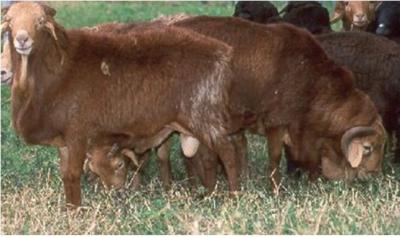
(c) www. abc.net.au
Origin and distribution: The Red Maasai sheep are also called Tanganyika sheep. They are sheep of the semi-arid regions of Kenya and Tanzania. Currently they are mostly found in the semi-arid regions of southern Kenyan and northern Tanzanian rangelands, especially in Kajiado District of Kenya and the neighboring districts. Before the beginning of the 20th century, their keepers the pastoral Maasai tribesmen used to occupy much wider areas, including the wetter parts of Kenya’s high and cool altitude plateaus, the upper eastern escarpments of the Great Rift Valley, such as the Kinangops, the lower slopes of the Aberdares Mountain ranges and the central highland such as, the once swampy areas of where the city of Nairobi is located.
The red Masai sheep are tolerant and/or resistant to the notorious Haemonchus contortus parasite. They are predominantly kept by the Maasai pastoralists as well as by the neighboring tribes.
Physical characteristics: The Red Maasai sheep is identified by its relatively large body size and thick red hair. However, when all of the strains are considered, the sheep are multicolored, the most preferred color by the Maasai and therefore the commonest being red, brown and occasionally pied. Average height at withers is 73 (range = 72-75) cm for males and 62 (range = 58-66) cm for females. Average heart girth and body length for females are 75.1 cm and 63.3 cm, respectively. They are short, fat-tailed and slightly fat-rumped. In populations where a fat rump is a predominant feature indicate that they may in times past have crossed with either Dorper or Black Head Somali/Persia sheep.
Peculiarity: It resists worms and other diseases. On two indicators that together provide a reasonably reliable picture of resistance – faecal egg count and packed cell volume – Red Maasai ewes and lambs performed significantly better than Dorper sheep. The associated lowered mortality rates led to much faster flock growth and productivity. The breed has also been shown to resist bluetongue virus infection and a more suited breed to survive under high trypanosome challenge.
Utility: The Red Maasai are used for their mutton and lard. Their reproductive performance in terms of lambing rate, is reported to be 80-84%, which is comparable to the Dorper sheep breed under medium rainfall zones in Kenya; the lambing interval is about 340 days, which is long compared to other East African sheep breeds, but can be improved to 246 days when crossed with the Dorper; the average litter size is about 1.13-1.21, which is lower than the Dorper and their crosses.
- The average birth weight is 2.7 kg and
- Average weaning weight is 15 kg with weaning rates at 97% and average daily gains at 128 gm respectively.
- Mature weight for males is on average 45.5kg and 35 kg for females.
- Pre-weaning daily weight gain is 105 gm for males and 98 gm for females.
- The mortality (death) rates (28%) of Red Maasai sheep is better than that of Dorper sheep (66%) under moderate to high worm (Haemonchus contortus) infections.
- Crosses between Dorper and Red Maasai performed 828 gm.
The scope for control of Helminthosis using treatments among the resource poor farmers is limited. That is why the Red Maasai sheep are recommended to pastoralist and smallholder farmers whose flocks experience a problem of severe haemonchosis.
c) Persian Blackhead
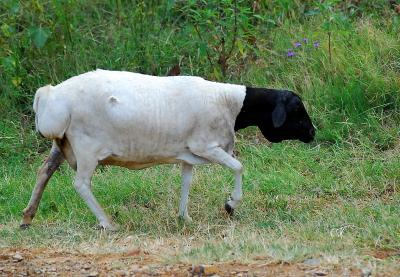
(c) Shi Zhao, Wikipedia
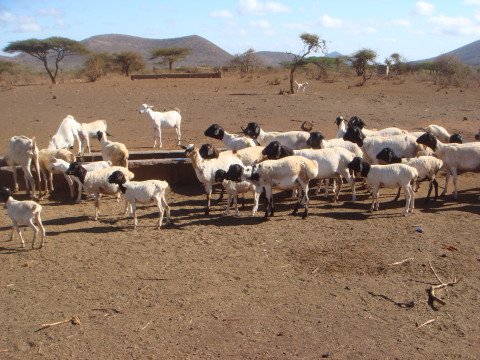
(c) Monique Hunziker, Biovision
The Blackhead Persian is a fat-tailed breed of domestic sheep. The sheep is originally from Somali land. The breed is also a type of hair sheep, meaning they do not grow wool and tolerate heat better than wooled breeds and are raised primarily for mutton. The Blackhead Persian has a white body and, as their name would suggest, an entirely black head. Both sexes are polled. On average at maturity, rams weigh 68 kg and ewes 52 kg. Average birth weight is 2.6 kg. Ewes lactate for approximately 84 days; produce 50 kg of milk with 5.9% fat.
Wool sheep
a) Merino sheep
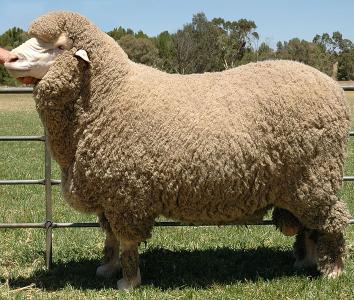
(c) C.Goodwin, wikipedia.org
Origin and distribution: Merino sheep were introduced into Africa in 1789 with imports of Spanish Merinos. By the mid-1800s the breed was spread over many parts of Africa. From 1891 onwards, American Vermont type Merinos were introduced. The African Merino is a composite of Spanish, Saxony, Rambouillet, American and Australian Merinos. These sheep are found mainly in semi-arid to sub-humid climates in Kenya and at medium to high altitudes under ranching and agro-pastoral management systems.
Physical characteristics: They are uni-coloured with white coat and fine-wool. They are heavy animals: males have 100 kg mature weight and females 60 kg. The average weights at birth, weaning and 18 months in female animals are 3.58 kg (range = 2.5-4.5 kg), 15.53 kg (range = 10.7-24.2 kg), and 56.2 kg (32.0-65.3 kg) respectively.
Peculiarity: The breed is adapted to high rainfall grassland regions. Animals of this breed are reported to be less susceptible to fly strike because of their smooth body in comparison to sheep with skin folds.
Utility: The Merino is mainly used for its wool; the fleece weight per year is 5.5 kg. Ewes produce an average of 7.15 kg wool ranging from 2.6-9.7 kg. The wool is medium to strong white, which is over-crimped in comparison to the Merino wool of the same strength. The wool on average measures 22-23 microns without any kemp fibres. Average staple length is 7.1 cm and ranges from 5.97-8.29 cm.
b) Corriedale
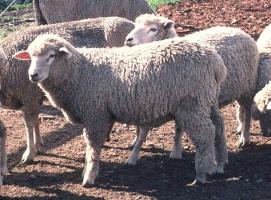
(c) Bob Nichols, wikipedia.org
Corriedale is a dual purpose breed, meaning they are used both in the production of wool and mutton. Corriedale have a long life span, and are hardy and evenly balanced all over the body. Corriedales are docile, easy care mothers, with high fertility. They adapt well to a wide range of climate conditions. They are large framed and plain bodied, polled and have a broad body. Corriedales produce a thick stapled, bulky fleece, which is popular with spinners and can be used for a range of handspun garments. Their dense fleece is medium-fine and high yielding, with good length and softness, somewhat between medium wool and long wool. Corriedale lambs produce good quality carcasses and have a high pelt value.
The Corriedale produces bulky, high-yielding wool ranging from 31.5 to 24.5 microns diameter. Fleece from a mature ewe will weigh 4.5 to 7.7 kg with a staple length of 8.9 to 15 cm. After cleaning, a yield of 50 to 60% of the raw fleece weight is common. Mature rams will weigh 79 to 125 kg, ewes can weigh from 59 to 82 kg.
c) Romney Marsh sheep

(c) Steven Walling, wikipedia.org
The Romney is in general an open-faced breed with long wool that grows over the legs in full.
Description:
Head wide, level between ears, with no horns or dark hair on the poll. Eyes are large, bright and prominent and the mouth sound. Face in ewes full, and in rams broad and masculine in appearance. Nose and hooves are black. Neck well set in at the shoulders, strong and not too long. Shoulders well put in and level with the back. Chest is wide and deep; back straight and long, with a wide and deep loin; Rump wide, long and well-turned. Tail set almost even with the chine. Thighs well let down and developed. The face is white, and the skin is of pink pigmentation. Ribs are well sprung; legs well set, with good bone and sound feet. Sheep stand well on their pasterns. The fleece is of white colour, even texture and a good decided staple from top of head to end of tail and free from kemp.
Fleece characteristics
Romneys produce a heavy fleece. A healthy mature ram can yield at shearing upwards of 10 kg per year, while flock averages for breeding ewes are typically above 5 kg. The increased fleece weight of a long-wooled sheep comes from the longer fiber length produced. The “clean yield” (net weight after thorough washing) is typically high for Romneys, 75-80%; this is a higher yield than is got for most fine-wooled sheep.